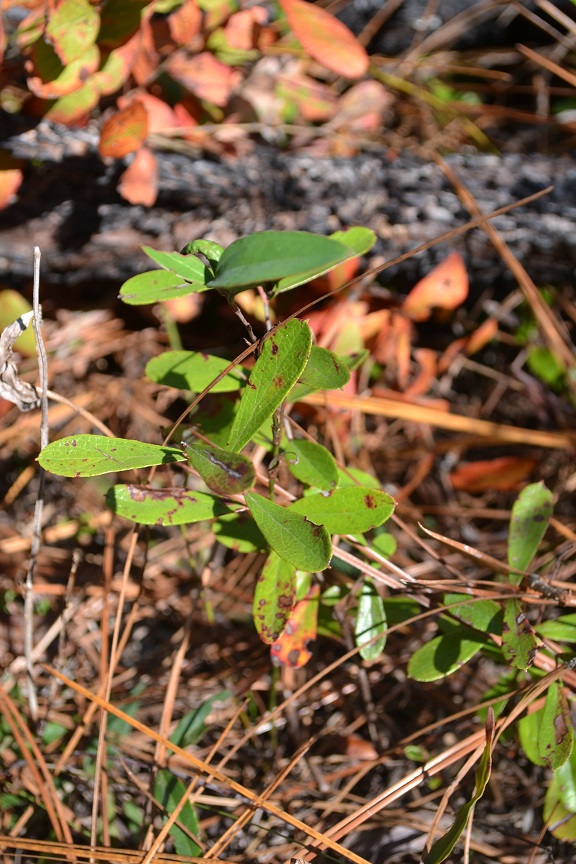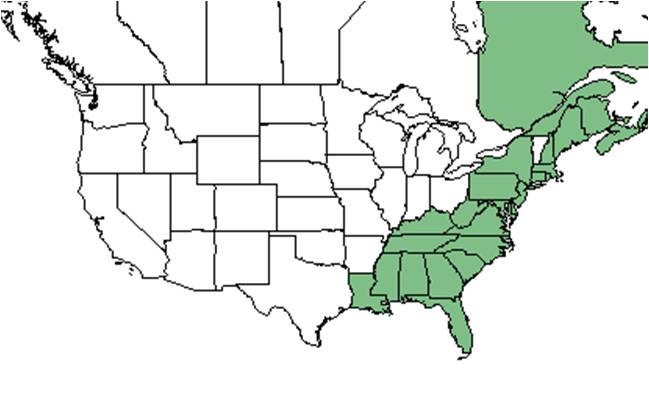Gaylussacia dumosa
| Gaylussacia dumosa | |
|---|---|

| |
| Photo taken by Kevin Robertson | |
| Scientific classification | |
| Kingdom: | Plantae |
| Division: | Magnoliophyta - Flowering plants |
| Class: | Magnoliopsida - Dicotyledons |
| Order: | Ericales |
| Family: | Ericaceae |
| Genus: | Gaylussacia |
| Species: | G. dumosa |
| Binomial name | |
| Gaylussacia dumosa (Andrews) Torr. & A. Gray | |

| |
| Natural range of Gaylussacia dumosa from USDA NRCS Plants Database. | |
Common names: Dwarf huckleberry; Southern dwarf huckleberry
Contents
Taxonomic notes
Synonyms: Gaylussacia dumosa (Andrews) Torrey var. dumosa; Lasiococcus dumosus (Andrews) Small
Description
A description of Gaylussacia dumosa is provided in The Flora of North America.
Distribution
Ecology
Habitat
Gaylussacia dumosa is restricted to native groundcover with a statistical affinity in upland pinelands of South Georgia. [1] G. dumosa responds negatively to soil disturbance in longleaf pine communities in South Carolina.[2]
Phenology
G. dumosa has been observed to flower March to May and in October with peak inflorescence in April.[3]
Seed dispersal
This species is thought to be dispersed by consumption by vertebrates. [4] In particular, it has found to be dispersed by gopher tortoise (Gopherus polyphemus).[5]
Pollination
The following Hymenoptera families and species were observed visiting flowers of Gaylussacia dumosa at Archbold Biological Station: [6]
Apidae: Apis mellifera, Bombus impatiens
Halictidae: Augochlorella aurata, A. gratiosa
Megachilidae: Megachile brevis pseudobrevis, M. integrella
Conservation and management
Cultivation and restoration
Photo Gallery
References and notes
- ↑ Ostertag, T.E., and K.M. Robertson. 2007. A comparison of native versus old-field vegetation in upland pinelands managed with frequent fire, South Georgia, USA. Pages 109–120 in R.E. Masters and K.E.M. Galley (eds.). Proceedings of the 23rd Tall Timbers Fire Ecology Conference: Fire in Grassland and Shrubland Ecosystems.
- ↑ Brudvig, L.A. and E.I. Damchen. (2011). Land-use history, historical connectivity, and land management interact to determine longleaf pine woodland understory richness and composition. Ecography 34: 257-266.
- ↑ Nelson, G. PanFlora: Plant data for the eastern United States with emphasis on the Southeastern Coastal Plains, Florida, and the Florida Panhandle. www.gilnelson.com/PanFlora/ Accessed: 9 DEC 2016
- ↑ Kay Kirkman, Jones Ecological Research Center, unpublished data, 2015.
- ↑ Carlson, J. E., E. S. Menges, and P. L. Marks. 2003. Seed dispersal by Gopherus polyphemus at Archbold Biological Station, Florida. Florida Scientist, v. 66, no. 2, p. 147-154.
- ↑ Deyrup, M.A. and N.D. 2015. Database of observations of Hymenoptera visitations to flowers of plants on Archbold Biological Station, Florida, USA.
